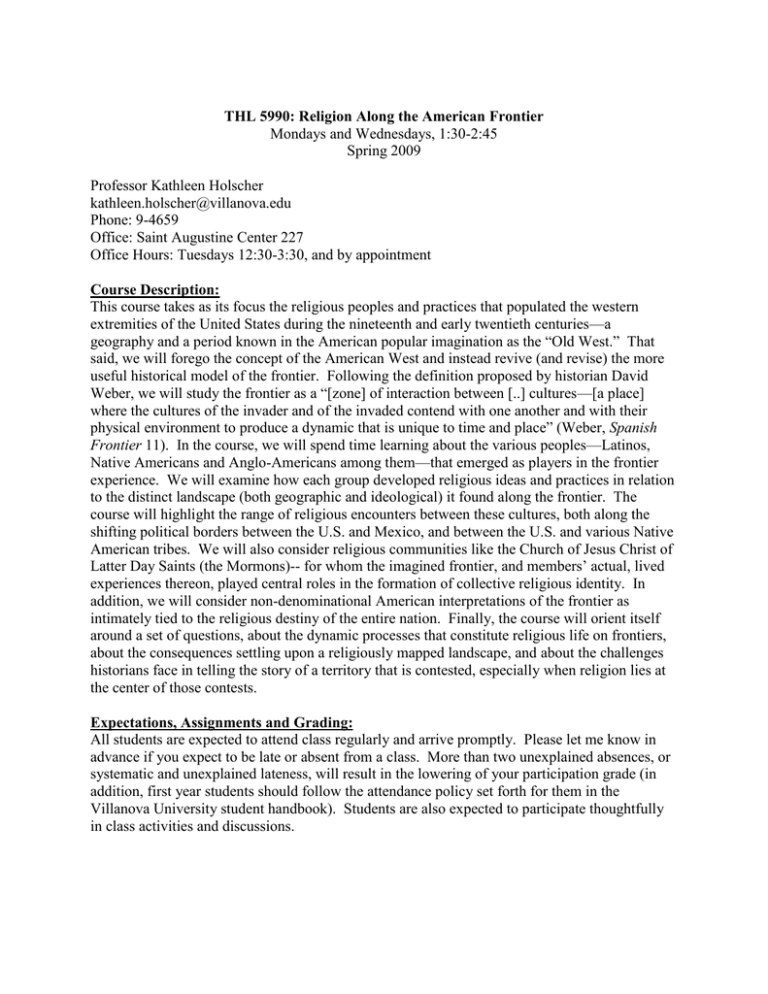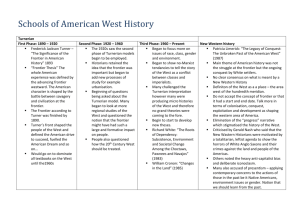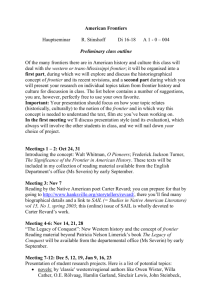Religion along the American Frontier
advertisement

THL 5990: Religion Along the American Frontier Mondays and Wednesdays, 1:30-2:45 Spring 2009 Professor Kathleen Holscher kathleen.holscher@villanova.edu Phone: 9-4659 Office: Saint Augustine Center 227 Office Hours: Tuesdays 12:30-3:30, and by appointment Course Description: This course takes as its focus the religious peoples and practices that populated the western extremities of the United States during the nineteenth and early twentieth centuries—a geography and a period known in the American popular imagination as the “Old West.” That said, we will forego the concept of the American West and instead revive (and revise) the more useful historical model of the frontier. Following the definition proposed by historian David Weber, we will study the frontier as a “[zone] of interaction between [..] cultures—[a place] where the cultures of the invader and of the invaded contend with one another and with their physical environment to produce a dynamic that is unique to time and place” (Weber, Spanish Frontier 11). In the course, we will spend time learning about the various peoples—Latinos, Native Americans and Anglo-Americans among them—that emerged as players in the frontier experience. We will examine how each group developed religious ideas and practices in relation to the distinct landscape (both geographic and ideological) it found along the frontier. The course will highlight the range of religious encounters between these cultures, both along the shifting political borders between the U.S. and Mexico, and between the U.S. and various Native American tribes. We will also consider religious communities like the Church of Jesus Christ of Latter Day Saints (the Mormons)-- for whom the imagined frontier, and members’ actual, lived experiences thereon, played central roles in the formation of collective religious identity. In addition, we will consider non-denominational American interpretations of the frontier as intimately tied to the religious destiny of the entire nation. Finally, the course will orient itself around a set of questions, about the dynamic processes that constitute religious life on frontiers, about the consequences settling upon a religiously mapped landscape, and about the challenges historians face in telling the story of a territory that is contested, especially when religion lies at the center of those contests. Expectations, Assignments and Grading: All students are expected to attend class regularly and arrive promptly. Please let me know in advance if you expect to be late or absent from a class. More than two unexplained absences, or systematic and unexplained lateness, will result in the lowering of your participation grade (in addition, first year students should follow the attendance policy set forth for them in the Villanova University student handbook). Students are also expected to participate thoughtfully in class activities and discussions. Essays: Students will complete three essays throughout the course of the semester. Each essay will be 5 pp. in length. Two essays will draw on readings assigned for the class, while one may require a moderate amount of outside reading and/or research. Topics will be distributed two to three weeks before each essay is due. Final Exam: The final exam will be an open book, take home exam, and will be cumulative (in other words, it will cover readings and class content from the entire course). It will be distributed on the final day of classes, and must be completed and submitted in hard copy to my office by 4:00 PM on the following Wednesday. Please note that the exam (like any exam) is not a collaborative effort—each student should complete the exam privately, and refrain from sharing their work with other students. Reading Responses: Students must complete weekly reading responses over the course of the semester. Each response should directly address one or more reading assignments. For each response, the student should take a few sentences to articulate at least one informed opinion about themes or topics broached in the assigned reading(s), and at least one question inspired by the reading. Each response can be either typed or (legibly) handwritten. Responses must be turned in during the class for which the reading in question was assigned, and only one response may be turned in per week. Do not write responses for weeks 1 or 14. Ten responses are required for the semester; additional responses will count toward extra credit for the course. Students are also encouraged to raise questions or concerns they have, about reading assignments or lecture content, either in class or during office hours. Breakdown of Grading: Three essays Final Exam Reading responses (10 x 1%) Attendance and Participation Grading Scale: 100-95: A 94-90: A89-86: B+ 85-82: B 81-78: B77-75: C+ 74-72: C 71-69: C68-65: D+ 65-62: D 62-60: DBelow 60: F 15% each 30% 10% 15% All materials written by students for this course (and all courses at Villanova) must adhere to the university’s code of academic integrity. To learn about plagiarism and other issues of academic integrity visit http://library.villanova.edu/Help/AcademicIntegrity . From this website you can link to Villanova’s integrity code, as well as several helpful educational resources. If you have any questions at all about proper documentation, and other techniques to assure you avoid plagiarism, please don’t hesitate to see me. Students with Disabilities: Students with disabilities who require academic accommodations should meet to discuss specifics with me. It is the policy of Villanova University to make reasonable academic accommodations for qualified individuals with disabilities. To receive accommodations, you must present verification, and to do this you must register with the Learning Support Office by contacting the office at 610-519-5636 or at nancy.mott@villanova.edu. Required Texts: Books for this course are available in the UShop in Kennedy Hall. Richard Etulain. Does the Frontier Experience Make America Exceptional? Bedford / St. Martins, 1999. Linda Gordon. The Great Arizona Orphan Abduction. Harvard University Press, 2001. Joel Martin. The Land Looks After Us. Oxford University Press, 2001. W. Paul Reeve. Making Space on the Western Frontier. University of Illinois Press, 2007. David Weber. The Spanish Frontier in North America. Yale University Press, 1994. All other readings for the course are available either through e-reserve (the e-reserve folder is located on the course’s blackboard homepage). Weekly Outline: Part I: Background, Questions, Themes Week 1: The “West” in American Religious History January 12th: Introductory materials; “frontier,” Oxford English Dictionary (handout). January 15th: Edwin Gaustad and Leigh Schmidt, The Religious History of America, Ch. 8 Week 2: The Frontier as an Interpretive Model January 19th: No Class January 21st: Frederick Jackson Turner, “The Significance of the Frontier in American History” and Patricia Nelson Limrick, from “Western History: Why the Past May be Changing,” Richard Etulain, ed., Does the Frontier Experience Make America Exceptional?, 17-43, 108-13. Part II: The Spanish Frontier Week 3: Religion on the Spanish Frontier: Encounters January 26th: Joel Martin, The Land Looks After Us, 5-29. January 28th: David Weber, The Spanish Frontier in North America, 1-29, 92-121; “First Encounters,” Presente!: U.S. Latino Catholics from Colonial Origins to the Present (Timothy Matovina, Gerald Eugene Povo, eds.), 9-14 Week 4: Religion on the Spanish Frontier: Mission Era Life February 2nd: Weber 122-146; Ramon Gutierrez, from When Jesus Came the Corn Mothers Went Away, 39-94; “Testimony on Indian Rebellion in New Mexico, 1681;” “Bishop’s Concerns About Language in New Mexico, 1760;” “Guideline for a Texas Mission;” “Good Friday Service in Santa Fe, New Mexico,” Presente! 14-17, 22-23, 25-27, 32-35. February 4th: “Inauguration of the Church at Mission Santa Clara,” “Accounts of Mission Life in California,” Presente! 23-25, 37-43; George Tinker, Missionary Conquests, 42-69; Excerpts from The Life of Fray Junipero Serra (handout). Part III: American Perceptions of the Frontier: Religious Promise, Religious Threat Week 5: Religious Promise and Progress February 9th: Jonathan Edwards, “The Latter Day Glory Is Probably to Begin in America.” February 11th: Conrad Cherry, “Westward the Course of Destiny” and Lyman Beecher, “A Plea for the West,” God’s New Israel: Religious Interpretations of American Destiny (Conrad Cherry, ed.), 51-60, 113-130; Walt Whitman, “Passage to India” (handout). Week 6: Protestant Anxiety and Home Missions February 16th: Horace Bushnell, “Barbarism, The First Danger” (full text available for reading or download at www.books.google.com); Laurie Maffly-Kipp, “The Moral World of the Califonia Miner,” Religion and Society in Frontier California, 110-47. February 18th: *first essay due* Maffly-Kipp, “Engaging Habits and Besotted Idolatry,” Material Religion 1.1 (2005) 72. Part IV: Mormons Week 7: The Mormon Zion February 23rd: Reeve, Making Space on the Western Frontier, 1-32; Shipps, “History as Text,” Mormonism 41-65. February 25th: Reeve, 33-62; Mary Ann Hafen, “Pioneer Life in Southern Utah;” Brigham Young, “Discourses” (handout). --Spring Break— Week 8: Mormon Encounters and Conflict Marth 9th: Reeve 63-112. March 11th: Reeve 113-56. Part V: American Indians Week 9: Indian Missions and Christianization March 16th: Martin 61-83; Henry Warner Bowden, American Indians and Christian Missions, 164-97. March 18th: Charles A. Eastman, “From the Deep Woods to Civilization” and Gertrude Bonnin (Zitkala Sa) “Impressions of an Indian Childhood,” Native American Autobiography: An Anthology (ed. Arnold Krupat), 258-97. Week 10: Messianic Movements March 23rd: Martin 84-113. March 25th: *second essay due* James Mooney, The Ghost Dance Religion and Wounded Knee, 777-83, 915-27. Part VI: Catholics and Borderlands Week 11: Catholic Expansion March 30th: Josiah Strong, Our Country, 13-18, 27-40, 59-88. April 1st: Sister Blandina Segal, At the End of the Santa Fe Trail (selections). Week 12: Religious and Ethnic Borderlands April 6th: James S. Griffith, Folk Saints of the Borderlands, 21-41; Paul Vanderwood, “Criminals and Saints,” Juan Soldado 201-48. April 8th: Linda Gordon, The Great Arizona Orphan Abduction, 1-79. Week 13: Religious Practice on the Borderlands April 13th: No Class April 15th: Gordon 80-208, 246-253, 275-313. Part VII: Conclusions Week 14: New Religions on the Frontier April 20th: Movie Screening: Waco: The Rules of Engagement (1997) April 22nd: Waco: The Rules of Engagement (cont.) Week 15: Final Thoughts April 27: Etulain 121-26; Laurie Maffly-Kipp, “Eastward Ho! American Religion from the Perspective of the Pacific Rim,” Retelling U.S. Religious History (Thomas Tweed, ed.), 127-48. April 29: *third essay due* Wrap-Up






